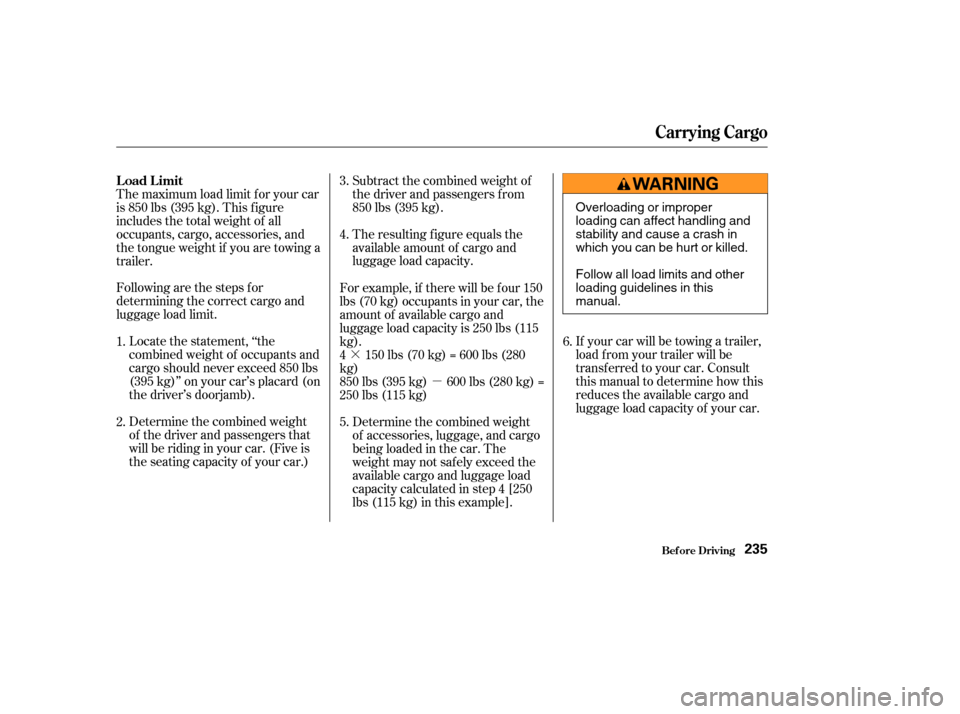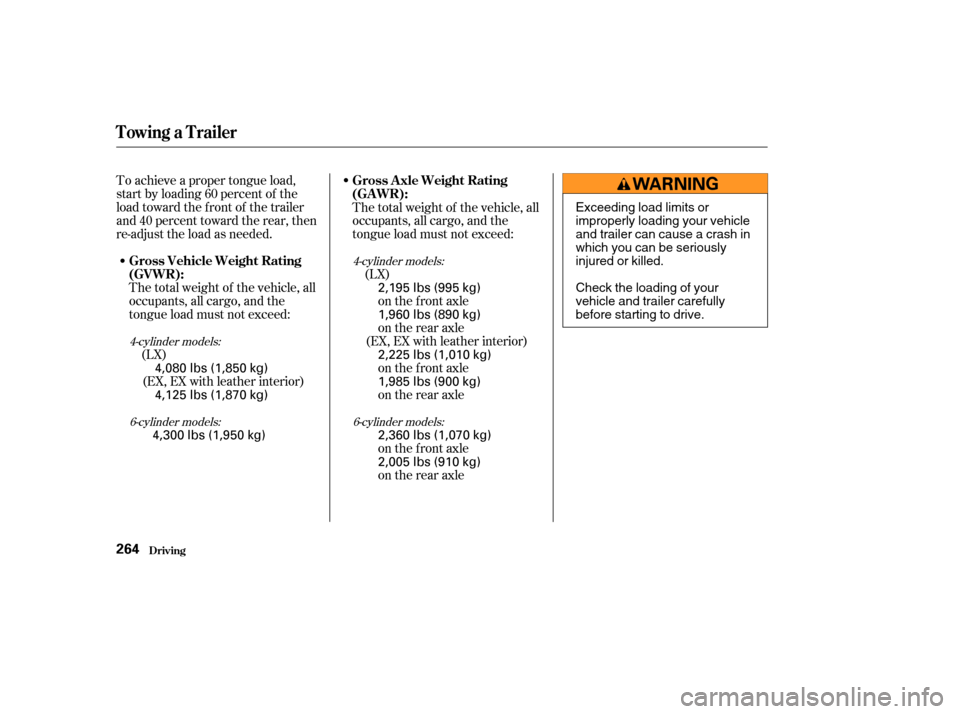Page 237 of 429
Your car has several convenient
storage areas so you can stow cargo
saf ely.
The glove box, and the pockets in
the doors and seat-backs, are
designed f or small, lightweight items.
The trunk is intended f or larger,
heavier items. In addition, the back
seatcanbefoldeddowntoallowyou
to carry more cargo or longer items.
However, carrying too much cargo,
or improperly storing it, can af f ect
your car’s handling, stability,
stopping distance, and tires, and
make it unsaf e. Bef ore carrying any
type of cargo, be sure to read the
f ollowing pages.
Carrying Cargo
Bef ore Driving234
CONSOLE COMPARTMENTTRUNK GLOVE BOX
CENTER POCKET
DOOR POCKET
SEAT-BACK POCKETS
Page 238 of 429

�·�µ
Following are the steps f or
determining the correct cargo and
luggage load limit.
Locate the statement, ‘‘the
combined weight of occupants and
cargo should never exceed 850 lbs
(395 kg)’’ on your car’s placard (on
the driver’s doorjamb). Subtract the combined weight of
the driver and passengers f rom
850 lbs (395 kg).
The resulting f igure equals the
available amount of cargo and
luggage load capacity.
If your car will be towing a trailer,
load f rom your trailer will be
transf erred to your car. Consult
this manual to determine how this
reduces the available cargo and
luggage load capacity of your car.
The maximum load limit f or your car
is 850 lbs (395 kg). This f igure
includes the total weight of all
occupants, cargo, accessories, and
the tongue weight if you are towing a
trailer.
Determine the combined weight
of the driver and passengers that
will be riding in your car. (Five is
the seating capacity of your car.) For example, if there will be f our 150
lbs(70kg)occupantsinyourcar,the
amount of available cargo and
luggage load capacity is 250 lbs (115
kg).
4 150 lbs (70 kg) = 600 lbs (280
kg)
850 lbs (395 kg) 600 lbs (280 kg) =
250 lbs (115 kg)
Determine the combined weight
of accessories, luggage, and cargo
beingloadedinthecar.The
weight may not saf ely exceed the
available cargo and luggage load
capacity calculated in step 4 [250
lbs(115kg)inthisexample].
1.
2. 3.
4.
5.
6.
Load Limit
Carrying Cargo
Bef ore Driving235
Overloading or improper
loading can affect handling and
stability and cause a crash in
which you can be hurt or killed.
Follow all load limits and other
loading guidelines in this
manual.
Page 239 of 429

Distribute cargo evenly on the
f loor of the trunk, placing the
heaviest items on the bottom and
as f ar f orward as possible.
If youfolddownthebackseat,tie
down items that could be thrown
about the car during a crash or
sudden stop.
If you carry large items that
prevent you f rom closing the trunk
lid, exhaust gas can enter the
passenger area. To avoid the
possibility of, f ollow the instructions
on page .
Do not put any items on top of the
rear shelf . They can block your
view and be thrown around the car
during a crash.
If you can carry any items on a
roof rack, be sure the total weight
of the rack and the items does not
exceed the maximum allowable
weight. Please contact your Honda
dealer f or f urther inf ormation.
Be sure items placed on the f loor
behind the f ront seats cannot roll
under the seats and interf ere with
the driver’s ability to operate the
pedals, or with the proper
operation of the seats.
Keep the glove box closed while
driving. If it is open, a passenger
could injure their knees during a
crash or sudden stop. Store or secure all items that could
be thrown around and hurt
someone during a crash.
56
Carrying Cargo in the Trunk or on
a Roof T op Carrier
carbon monoxide
poisoning
Carrying Items in the Passenger
Compartment
Carrying Cargo
Bef ore Driving236
Page 266 of 429
Your Honda has been designed
primarily to carry passengers and
their cargo. You can use it to tow a
trailer if you caref ully observe the
load limits, use the proper equipment,
and f ollow the guidelines in this
section.The weight that
the tongue of a f ully-loaded trailer
puts on the hitch should be
approximately 10 percent of the
trailer weight. Too little tongue
load can make the trailer unstable
and cause it to sway. Too much
tongue load reduces f ront-tire
traction and steering control.
The total
weight of the trailer and
everything loaded in it must not
exceed 1,000 lbs (450 kg). Towing
a load that is too heavy can
seriously af f ect your car’s
handling and perf ormance. It can
also damage the engine and
drivetrain.
CONT INUED
Towing a Trailer
Driving
Tongue Load:
Load Limits
T otal T railer Weight:
263
Page 267 of 429

To achieve a proper tongue load,
start by loading 60 percent of the
load toward the front of the trailer
and 40 percent toward the rear, then
re-adjust the load as needed.The total weight of the vehicle, all
occupants, all cargo, and the
tongue load must not exceed: The total weight of the vehicle, all
occupants, all cargo, and the
tongue load must not exceed:
(LX) (EX, EX with leather interior) (LX)
on the f ront axle
on the rear axle
(EX, EX with leather interior)
on the f ront axle
on the rear axle
on the f ront axle
on the rear axle
4-cylinder models:
6-cylinder models: 4-cylinder models:
6-cylinder models:
Towing a Trailer
Driving
Gross Axle Weight Rating
(GA WR):
Gross Vehicle Weight Rating
(GVWR):
264
4,080 lbs (1,850 kg)
4,125 lbs (1,870 kg)
4,300 lbs (1,950 kg) 2,195 lbs (995 kg)
1,960 lbs (890 kg)
2,225 lbs (1,010 kg)
1,985 lbs (900 kg)
2,360 lbs (1,070 kg)
2,005 lbs (910 kg)Exceeding load limits or
improperly loading your vehicle
and trailer can cause a crash in
which you can be seriously
injured or killed.
Check the loading of your
vehicle and trailer carefully
beforestartingtodrive.
Page 268 of 429
Discuss your needs with your trailer
sales or rental agency, and f ollow the
guidelines in the rest of this section.
Also make sure that all equipment is
properly installed and that it meets
f ederal, state, province, and local
regulations. Towing can require a variety of
equipment, depending on the size of
your trailer, how it will be used, and
how much load you are towing.
The best way to conf irm that vehicle
and trailer weights are within limits
is to have them checked at a public
scale.
Using a suitable scale or a special
tongue load gauge, check the tongue
load the f irst time you set up a
towing combination (a f ully-loaded
car and trailer), then recheck the
tongue load whenever the conditions
change. Any hitch used on your car must be
properly bolted to the underbody.
CONT INUED
Towing a Trailer
Driving
T owing Equipment and
A ccessories
Checking L oadsHitches
265
Page 269 of 429

Trailer lights and equipment must
comply with federal, state, and local
regulations. Check with your local
recreational vehicle dealer f or the
requirements in your area, and use
only equipment designed f or your
vehicle.
Since lighting and wiring vary by
trailer type and brand, you should
have a qualif ied technician install a
suitable connector between the
vehicle and the trailer. Improper
equipment or installation can cause
damage to your vehicle’ s electrical
system and af f ect your vehicle
warranty.
Always use saf ety chains. Make sure
they are secured to both the trailer
and hitch, and that they cross under
the tongue so they can catch the
trailer if it becomes unhitched.
Leave enough slack to allow the
trailer to turn corners easily, but do
not let the chains drag on the ground.
Honda recommends that any trailer
having a total weight of 1,000 lbs
(450 kg) or more be equipped with
its own electric or surge-type brakes.
If you choose electric brakes, be
sure they are electronically actuated.
Do not attempt to tap into your car’s
hydraulic system. No matter how
successf ul it may seem, any attempt
to attach trailer brakes to your car’s
hydraulic system will lower braking
ef f ectiveness and create a potential
hazard.
Seeyourtrailerdealerformore
inf ormation on installing electric
brakes.
Towing a Trailer
Driving
T railer L ights
Saf et y Chains T railer Brakes
266
Page 270 of 429

Many states and Canadian provinces
require special outside mirrors when
towing a trailer. Even if they don’t,
you should install special mirrors if
you cannot clearly see behind you, or
if the trailer creates a blind spot.
Askyourtrailersalesorrental
agency if any other items are
recommended or required f or your
towing situation.When preparing to tow, and bef ore
driving away, be sure to check the
f ollowing:
All weights and loads are within
limits (see pages and ).
Thehitch,safetychains,andany
other attachments are secure.
Allitemsonandinthetrailerare
properly secured and cannot shif t
while you drive. The car has been properly
serviced, and the tires, brakes,
suspension, and cooling system
are in good operating condition.
The lights and brakes on your car
and the trailer are working
properly. Your car tires and spare are
properly inf lated (see page ),
and the trailer tires and spare are
inflated as recommended by the
trailer maker.
263 264 334
Additional Trailer EquipmentPre-T ow Checklist
Towing a Trailer
Driving267